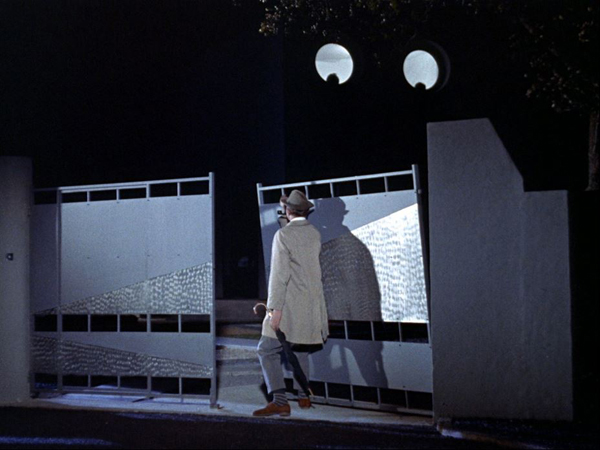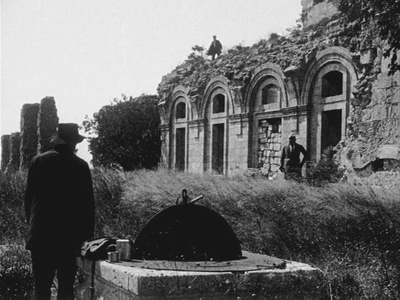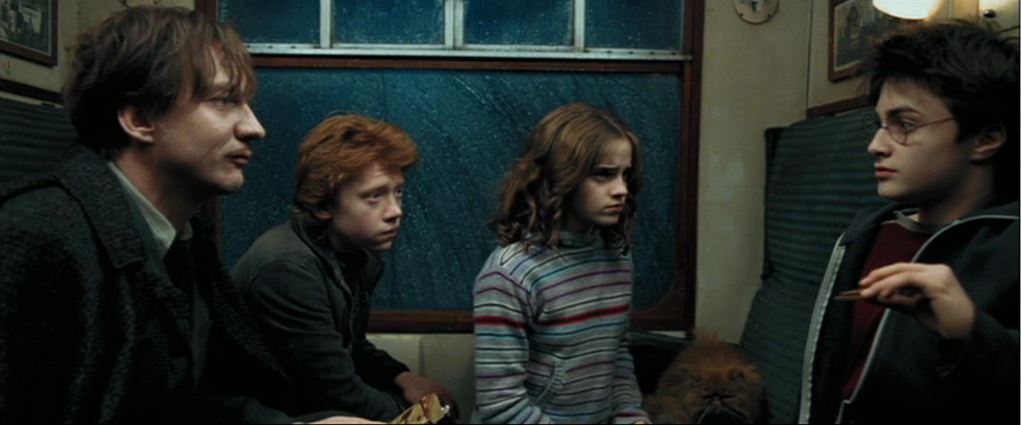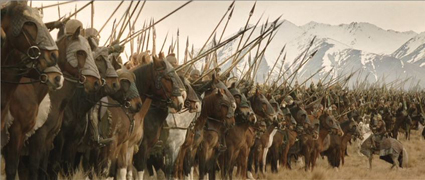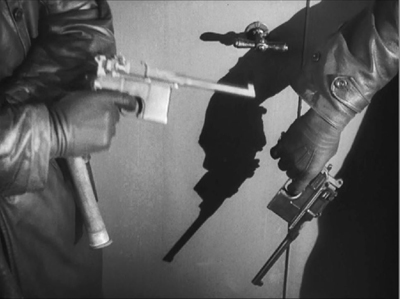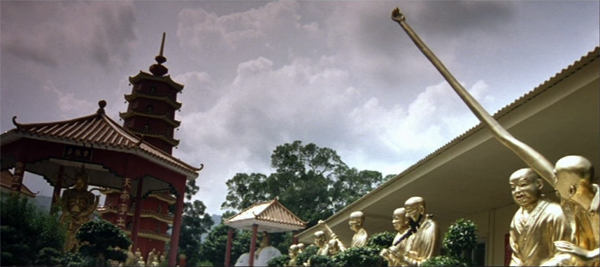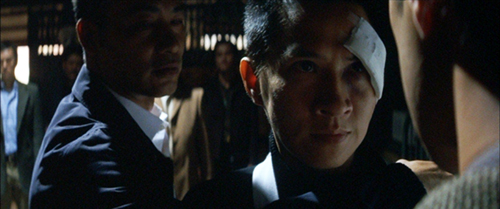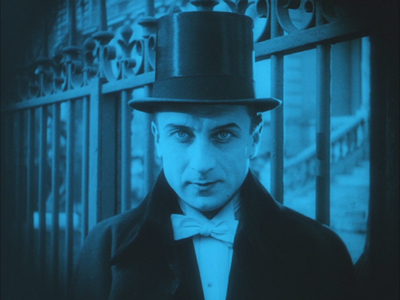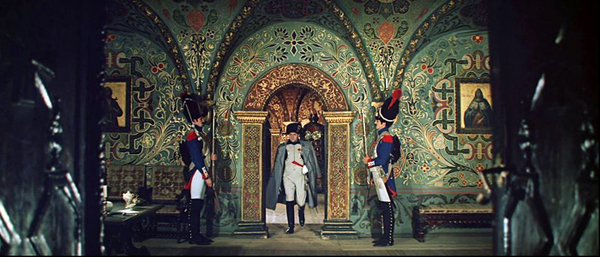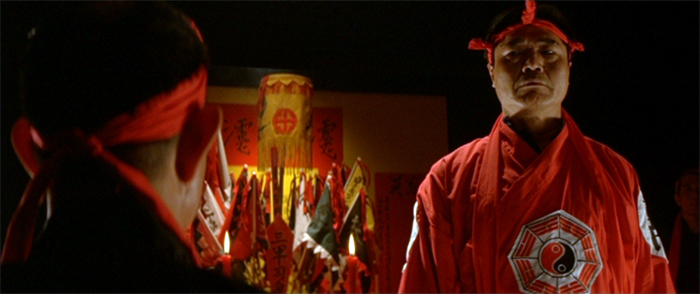Quality bingeing
Sunday | April 19, 2020 open printable version
open printable version
Mon Oncle (1958)
Kristin here:
Or binging, if you prefer. Either is an acceptable spelling.
Streaming entertainment is one of the things that are saving our sanity as we sit in our homes. With the theaters closed and new movies either delayed or sent straight to streaming, movie critics, other journalists, and movie buffs are now making best-films-to-stream-during-the-pandemic lists a new and common genre across the internet.
Maybe you’ve been streaming a lot of TV series, even ones you’ve already seen, and are feeling a bit guilty about that. Maybe you’re longing for something more worthwhile to watch but wishing that that something would take up more time than your average feature film.
For those people, I offer a list of films to binge. These are either long in themselves or are split up into many parts that can be binged just like TV series. Others are stand-alones but can be grouped in meaningful ways.
My experience is that online disc orders are taking longer than usual. With Amazon prioritizing health and work-at-home supplies, Blu-rays are taking around two weeks rather than two days. (David and I, of course, count Blu-rays and streaming as part of our work-at-home requirements.) While you’re waiting, I’ll bet many of you have some of these discs on your shelves already and have always meant to make time for them. That time, lots of it, has arrived.
Serials
Many fine serials were made in the silent era, but Louis Feuillade remains the director that most of us think of first in relation to this format. His three great serials of the 1910s (not including, alas, the fine Tih Minh [1918]) are available on home video.
Fantômas (1912). 5 episodes, 337 minutes. Fantômas is available in Blu-ray and DVD from Kino Lorber. David wrote a viewer’s guide to it here.
Les Vampires (1915). 10 episodes, 417 minutes. Les Vampires is available on Blu-ray and DVD from Kino Lorber. As far as I can tell, it is streaming only on Kanopy (apart from unwatchable public domain pre-restoration prints).
Judex (1917). 12 episodes, 315 minutes. Judex is ordinarily available from Flicker Alley, though it is currently listed as out of stock. Amazon has 5 left. For maximum bingeing opportunities, watch all three serials in a row and then stretch them out with Georges Franju’s charming remake, Judex (1963) for an extra 98 minutes (it’s $2.99 to stream it on Amazon Prime).
Miss Mend (Boris Barnet, 1926). Three episodes, 235 minutes. The only American-style serial from the Soviet Union that I know of, or at least the only one easily available. I wrote about it briefly when it first came out from Flicker Alley. You can still get it from Flicker Alley or Amazon. We wrote briefly about it here.
Le Maison de mystère (Alexandre Volkoff, 1923). 10 episodes, 383 minutes. I’ve already written in some detail about this long-lost serial. It’s probably not as good as Feuillade’s best, but it’s good fun and beautifully photographed (see top of section) and acted–and long enough to require a meal break. Fans of the great Ivan Mosjoukine (as he spelled his name after emigrating from Russia to France) will especially want to see this one. Available from Flicker Alley
Berlin Alexanderplatz (Rainer Werner Fassbender, 1980) 13 episodes and an epilogue. 15 hours, 31 minutes. Back when it first came out, this was treated more as a film than a TV series. It showed in 16mm at arthouses and archives. David and I drove to Chicago to see the whole thing in batches over a single weekend at The Film Center (now the Gene Siskel Film Center). It’s available on either DVD or Blu-ray as a Criterion Collection set (#411 for you Criterion number-lovers). It’s also streaming on the Channel. Both have a batch of supplements, even the 1931 German film of the novel, so you can stretch the experience out even longer.
Silent serials may work for some families, if the kids have been introduced to silents already through the more obvious route of films with Buster Keaton, Charlie Chaplin, and the other great comics of the era. If not, families can fill their time with more recent films in episodes with continuing stories.
The serial format has had a comeback in recent decades, partly due to the influence of the first Star Wars trilogy and partly to the need for ever expanding amounts of moving-image content in the era of home-video, cable, and internet services. For those who want to binge Star Wars, you don’t need my guidance. Anyway, I gave up after the first of the recent series, the one where Adam Driver took over as the villain. (Not that I have anything against Adam Driver. It was the film.) Even daily life in a pandemic is too short for more.
The Harry Potter series. (2001-2011) Eight episodes, 990 minutes, or 16.5 hours. This series is not high art, but it’s pretty good, highly entertaining (to some, at least), and even has one episode, number three, directed by Alfonso Cuarón, HP and the Prisoner of Askaban (above). The others are HP and the Sorcerer’s Stone (or Philosopher’s Stone in the UK and elsewhere; Chris Columbus), HP and the Chamber of Secrets (Chris Columbus), HP and the Goblet of Fire (Mike Newell), HP and the Order of the Phoenix, HP and the Half-Blood Prince, HP and the Deathly Hallows: Part I, and HP and the Deathly Hallows: Part II (the last four, David Yates). These films are, of course, available in multiple versions, on disc and streaming. As far as I can tell, none of the complete boxed sets have the two last parts in 3D; those have to be purchased separately. Having seen the last film in a theater in 3D, I can say that it doesn’t seem to be one of those films that is much improved if one sees it that way (unlike Mad Max: Fury Road, in the section below).
The Hobbit and The Lord of the Rings extended editions: An Unexpected Journey (2012), The Desolation of Smaug (2013), The Battle of the Five Armies (2014), The Fellowship of the Ring (2001), The Two Towers (2002), and The Return of the King (2003, above). 6 episodes, 1218 minutes, or 20 hours, 18 min. Yes, for sheer length this serial tops them all. Plus there are lots of supplements. Each part of the Hobbit films has one commentary track and a bunch of making-ofs, adding up to 40 hours, 5 1/2 minutes. This pales, however, in comparison with the LOTR extended editions, which have four commentary tracks, totaling 45 hours, 44 minutes. The making-ofs are hard to get exact figures for, but I estimate about 22 hours for all three films. That’s about 68 hours of audio and visual supplements.
To top that off, the Blu-ray set contains the three feature-length documentaries by Costa Botes: The Fellowship of the Rings: Behind the Scenes, The Two Towers: Behind the Scenes, and The Return of the King: Behind the Scenes, all adding another 5 hours, 2 1/2 minutes. (Botes’s films were also included in a “Limited Edition” reissue of the theatrical versions of the LOTR films in 2006.) In toto, if one watches every single item and listens to all the commentaries, one could escape 133 hours and 10 minutes of isolation boredom–and possibly go mad in the process. But treating the bingeing as an eight-hour-a-day job, it would come to 16 1/2 days.
All this does not include the supplements accompanying the theatrical-version discs. These are charming but more oriented toward introducing complete neophytes to the universe of Middle-earth than toward giving filmmaking information.
Series
Series, as opposed to serials, usually involve continuing characters but self-contained stories. Most of the series below could be watched out of order without suffering much. It would help to watch Mad Max first, since it’s an origin story. The Apu Trilogy should be watched in order because it’s about the central character’s stages of life. Each of the M. Hulot films bears the traces of the contemporary culture in which it is set, but one can understand each fine out of order. I saw Traffic first, in first run, and then saw the others.
Mad Max (1979), Mad Max 2, aka The Road Warrior (1981), Mad Max Beyond Thunderdome (1985), and Mad Max: Fury Road (2015) add up to 411 minutes, or 6 hours and 51 minutes. You know them, you love them–but have you ever watched them straight through? We’ve written about Fury Road (here and here). That’s a film where the 3D really does play an active role.
Jacques Tati’s Monsieur Hulot films: Mr. Hulot’s Holiday (1953), Mon Oncle (1958, see top), Play Time (1967), and Traffic (1971). They add up to 7 hours and 4 minutes. Or add his non-Hulot films, Jour de fête (1949) and Parade (1974) for just under an additional 3 hours of hilarity. You can buy all of Tati’s films at The Criterion Collection or stream them at The Criterion Channel. Throw in my “Observations on Film Art” segment on Parade for an extra 12 minutes. And check out Malcolm Turvey’s new book, Play Time: Jacques Tati and Comedic Modernism, soon to be discussed in a portmanteau books blog here.
Dr. Mabuse films plus Spione: Dr. Mabuse, der Spieler (1922), Spione (1928, frame above), The Testament of Dr. Mabuse (1933) and The Thousand Eyes of Dr. Mabuse (1960), adding up to 610 minutes, or 6 hours and 10 minutes. Few if any directors have extended a series over such a stretch of time, and the Mabuse films are quite different from each other (including having different actors play the master criminal). I throw Spione into the mix because the premise and tone are so similar to the first Mabuse film. Haghi is basically Mabuse as a master spy instead of a gambler and general creator of chaos; given that he’s played by Rudolf Klein-Rogge, who was the first Mabuse, the comparison is almost inevitable. One can almost imagine Haghi as just another of Mabuse’s disguises and it fits right into the series. I’ve linked the streaming sources to the titles above.
Kino Lorber has the restored version of Der Spieler on DVD and Blu-ray, Eureka has the restored version of Spione on DVD and Blu-ray (note: Region 2 coding) The Criterion Collection offers a DVD of Testament, and Sinister Cinema has a DVD of The 1,000 Eyes. (For those who want to dig deeper, there a Blu-ray set of all of Lang’s silents, from Kino Classics and based on the F. W. Murnau Stiftung restorations. That totals 1894 minutes, or about 31 and a half hours. I don’t know if that counts the supplements, but there are lots of them.)
Apu Trilogy: Pather Panchali (“Song of the Little Road,” but nobody calls it that, 1955), Aparajito (1956), and The World of Apu (1959). 341 minutes. Satyajit Ray’s trilogy may seem like a serial, in that it follows the life of the main character, Apu. Yet Ray had not planned a sequel until Pather Panchali achieved international success, and the films have big time gaps in between, with no dangling causes. These are three of the most beautiful, touching films ever made, and the stunning restoration from a damaged negative and other materials is little short of a miracle. If you have never seen these or saw them before the restoration, do yourself a favor and binge them. Have some tissues handy, and I don’t mean for stifling coughs and sneezes. Available on disc from The Criterion Collection and streaming on The Criterion Collection here, here, and here.
Now I briefly cede the keyboard to David for his recommendations of Hong Kong series.
Triads vs. cops, Triads vs. Triads
Infernal Affairs (2003).
There are many delightful Hong Kong series. I enjoy the silly Aces Go Places franchise (1982-1989) and the pulse-pounding Once Upon a Time in China saga (1991-1997). Alas, almost none of these installments entries are represented on streaming. I could find only the weakest OUATIC title, Once Upon a Time in China and America (1997) on Amazon Prime, Vudu, and iTunes.
If you want to go for samples, there are two diversions from the ever-lively Fong Sai-yuk series. The Legend (US title of the first entry, a bit pricy from Prime). The more reasonably priced Legend II, the US version of the second entry, has a fantastically funny martial-arts climax featuring Josephine Siao Fong-fong as Jet Li’s mom. This is available from several streamers. Older kids won’t find either one too rough, I think.
There are two outstanding series more suitable for adult bingeing. Infernal Affairs (2003-2004) was made famous by Scorsese’s remake The Departed (2006), but the original is better, and the follow-ups are loopier. The first entry offers solid, suspenseful plotting and meticulous performances by top HK stars Tony Leung Chui-wai and Andy Lau Tak-wah, supported by a rogues’ gallery of unforgettable character actors. Parts two and three spin off variations on the first one, tracing out before-and-after incidents and throwing in some quite strange narrative contortions. The whole thing provides an engrossing five and a half hours of entertainment. Available from several services.
In my book Planet Hong Kong I analyze the trilogy as an example of how directors Andrew Lau and Alan Mak Siu-fai created a more subdued thriller than is usual in their tradition. Bonus material: In the spirit of providing free stuff during the crisis, here in downloadable pdf form is my little chapter on the trilogy: Infernal Affairs interlude.
Also subdued, even subtle, is Johnnie To Kei-fung’s Election (2005) and Election 2 (aka Triad Election, 2006). These films dared to show secret gang rituals that other filmmakers shied away from. The first part plays out ruthless competition among rival Triad leaders, including strikingly unusual methods of punishing one’s adversary. The second entry, even more audacious, suggests that Hong Kong Triad power is intimately tied up with mainland Chinese gangs, backed up by political authority.
Johnnie To’s pictorialism, so feverish in The Longest Nite (1998), A Hero Never Dies (1998), The Mission (1999), and other films, gets a nice workout here as well. Infernal Affairs is agreeably moody, but the Election films are black, black noir.
The pair add up to three hours and a quarter. The first film is apparently available only on disc but the second is streaming from several sources.
Of course, to get into the real Hong Kong at-home experience, some viewers will find all these films easily and cost-free on the Darknet.
Thematic combos
Flicker Alley’s Albatros films. 5 films, 664 minutes, or 11 hours and 4 minutes. I wrote about the DVD set, “French Masterworks: Russian Émigrés in Paris 1923-1929” when it first came out. It’s still available here. The Albatros company made some of the key films of the 1920s, most of which are still too little known, including Ivan Mosjoukine’s Le brasier ardent (1923, above). If this is still a gap in your viewing of French films, here’s a chance to fill it.
Yasujiro Ozu: The Criterion Collection has released a helpful thematic grouping of some of Ozu’s early films. One is “The Silent Ozu: Three Family Comedies” (DVD and streaming), including I Was Born, but …, Tokyo Chorus, and Passing Fancy, adding up to 281 minutes. The British Film Institute has gone further along the same lines, releasing “The Gangster Films,” also three silents: Walk Cheerfully (1930), That Night’s Wife (1930), and the wonderful Dragnet Girl (1933); they add up to 259 minutes. The BFI has also put out “The Student Films,” (listed as out of stock at the moment) yet more silents: Ozu’s earliest complete surviving film, Days of Youth (1929), I Flunked, But … (1930), The Lady and the Beard (1931) , and Where Now Are the Dreams of Youth? (1932), adding up to 251 minutes.
David has recorded an entry on Ozu’s Passing Fancy for our sister series, “Observations on Film Art,” on the Criterion Channel; it should go online there sometime this year.
Or watch all the “season” films in a row: Late Spring (1949), Early Summer (1951), Early Spring ((1956), Equinox Flower (1958), Late Autumn (1960), End of Summer (1961), and An Autumn Afternoon (1962), for a grand total of 840, or 14 hours. Including An Autumn Afternoon is cheating a bit, since the original title means “The Taste of Mackerel.” Still, it’s so much like the earlier films in equating a season with a stage of life that the English title seems perfect. The early films equate the seasons with the young people, about to marry or recently married, while in the later films, and especially the last three, the seasons refer to the older generation, lending an elegiac tone to the end of Ozu’s career. David has done commentary for the DVD of An Autumn Afternoon.
All of these (except for Days of Youth) and many other Ozu films can be streamed on The Criterion Channel, which also has a bunch of supplements on this master director.
Or just watch The Criterion Channel’s Kurosawa films in chronological order, or Bresson’s or Godard’s or Bergman’s or …
Or watch all of Hideo Miyazaki’s films in chronological order, with or without the company of kids.
Just really long films
War and Peace (Sergei Bondarchuk, 1965-1967, above) 4 parts: 7 hours, 3 minutes, 44 seconds. I suppose this is technically a serial, since the parts were released over three years. Still, the idea presumably was that it ultimately should be seen as one film, and the running time would permit it being seen in one day fairly easily. I have not seen this restored version, only the considerably cut-down American release back when it first came out. I remember it as being quite conventional, but on a huge scale in terms of design, cinematography, and crowds of extras. Seeing it in its original version would no doubt be impressive (see above). Available on disc at The Criterion Collection and streaming on The Criterion Channel. The supplements total 175 minutes and four seconds, pushing the total up to nearly 10 hours.
Satan’s Tango (Béla Tarr, 1994) 450 minutes, or 7 hours 30 minutes. Film at Lincoln Center has just made Tarr’s epic available for streaming; you can rent it for 72 hours and support a fine institution. As to owning it, the DVDs seem to be out of print. There is, however, a Blu-ray coming from Curzon Artificial Eye on April 27 in the UK. Pre-order it here. Obviously many of us will still be stuck inside by the time it arrives. Or if you have it on the shelf and never quite got around to watching it, here’s your chance. Derek Elley’s Variety review sums up its pleasures. Our local Cinematheque has shown it twice, once in 35mm and more recently on DCP (see here, with the news buried at the bottom of the story). David reported on that first showing, and later he wrote a general entry about Tarr’s work on the occasion of having met the man himself.
Shoah (Claude Lanzmann, 1985) 550 minutes, or 9 hours and 10 minutes. The Holocaust examined through modern interviews with a broad range of people involved. Available in a restored version on disc from The Criterion Collection. It does not seem to be available currently for streaming.
Unclassifiable
Then there’s Dau (2020-), a biopic of a Soviet scientist that is perhaps the most ambitious filmmaking venture ever.
Shot on 35mm over three years in a real working town with 400 characters played by actors who remained in character and costume round the clock the whole time. Few have seen these, though two showed at the Berlin festival this year. We haven’t seen them but plan to give it a go, since they have just shown up online. Here’s a helpful summary of the project. At the Dau Cinema website, you can stream the first two films for $3 each: Dau. Natasha (2:17:53) and Dau. Degeneration, (6:09:06) adding up to 8 hours and 27 minutes. Twelve more films are announced for future release, with no timings given. Clearly not suitable for family viewing.
I have not attempted to add up all these timings, but if you can track most of them down, they might get you through much of the isolation period. Stay safe!
Election (2005).












